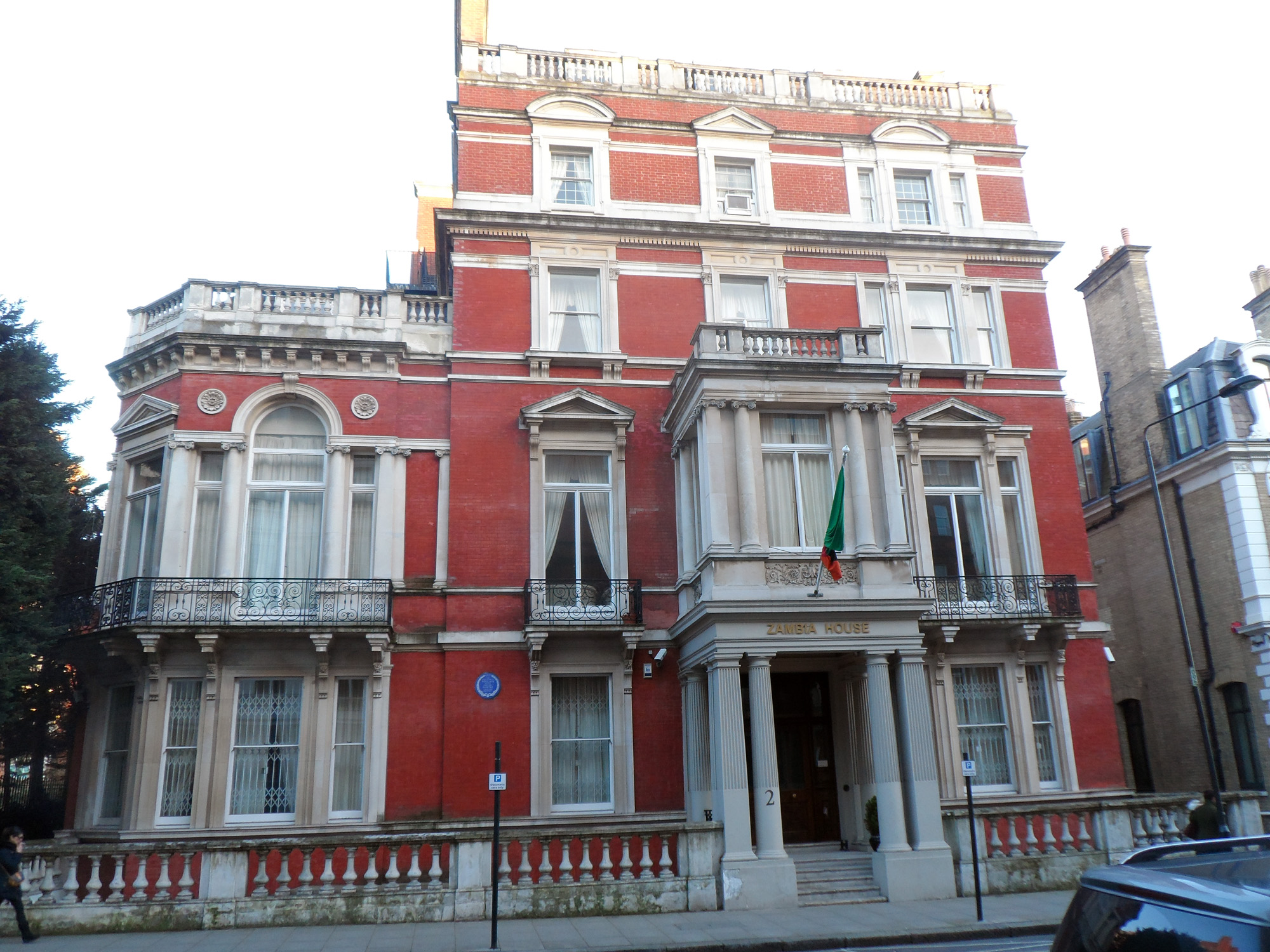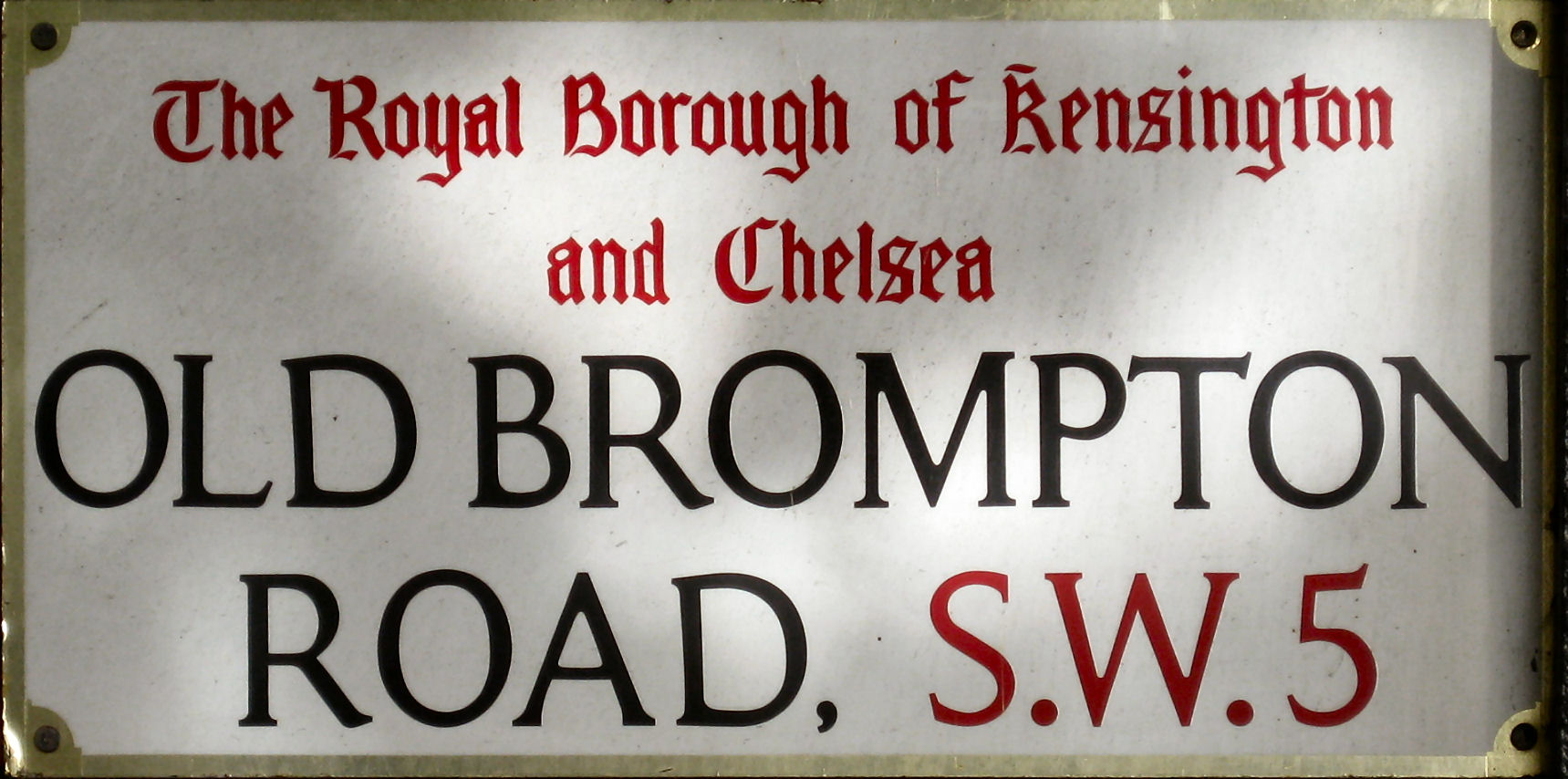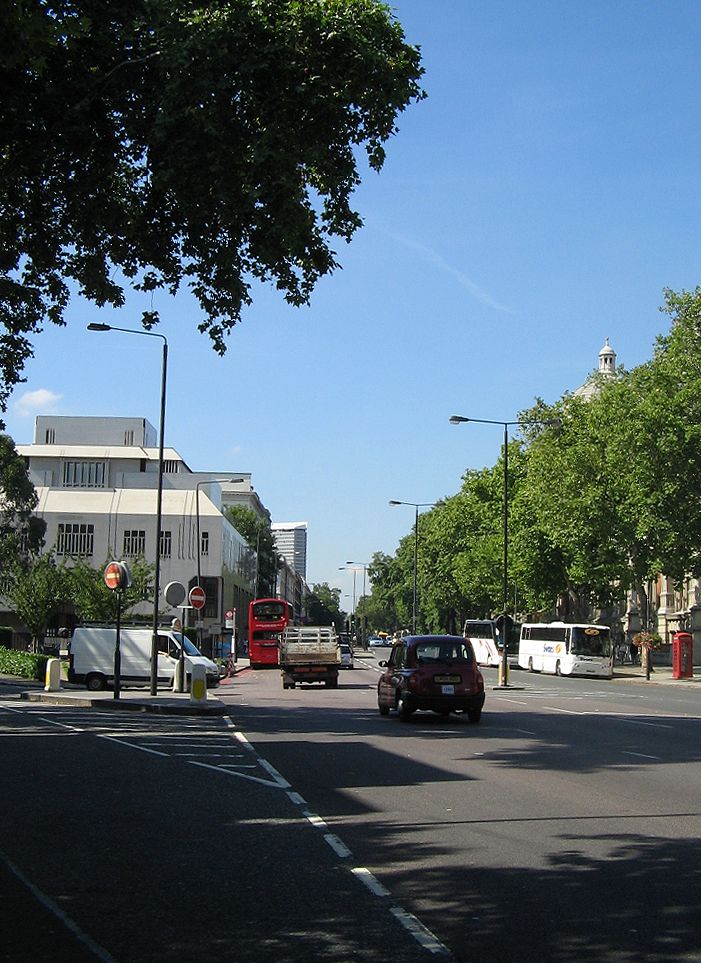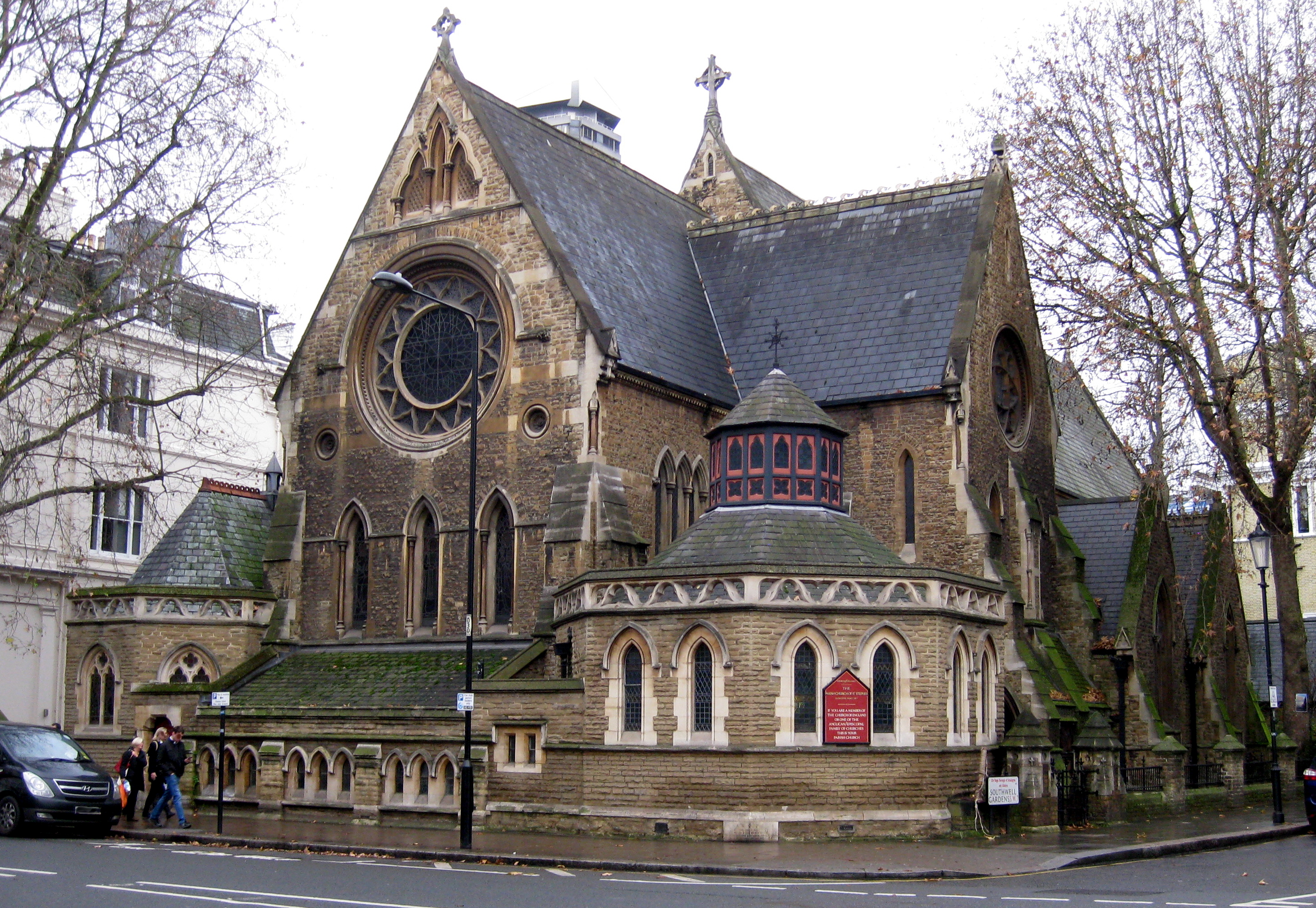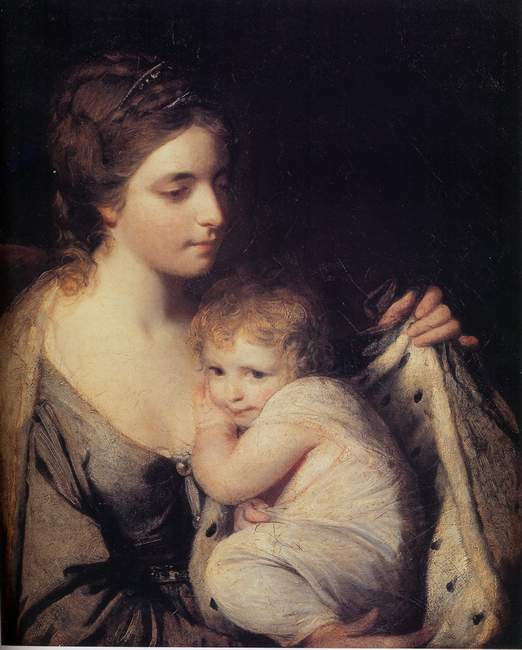|
Gloucester Road, London
Gloucester Road (B325) is a street in the Royal Borough of Kensington and Chelsea, London. It runs north–south between Kensington Gardens (at which point it is known as Palace Gate) and Old Brompton Road. At its intersection with Cromwell Road is Gloucester Road Underground station, close to which there are several pubs, restaurants, and hotels. St Stephen's Church was built in 1867: one of its former churchwardens was the poet T. S. Eliot. History The road is named after Maria, Duchess of Gloucester and Edinburgh who had a new house, Gloucester Lodge, built there by 1805. The road was earlier called Hog Moore Lane (1612), that is 'lane through marshy ground where hogs are kept', a name that was still used until about 1850. Gloucester Lodge was built by William Tyler, on the site of the former Florida Gardens, which the Duchess had acquired in 1797. The site is opposite the present day tube station. The Duchess, who had been widowed in 1805, lived at Gloucester Lodge w ... [...More Info...] [...Related Items...] OR: [Wikipedia] [Google] [Baidu] |
Gloucester Road Sign
Gloucester ( ) is a cathedral city and the county town of Gloucestershire in the South West of England. Gloucester lies on the River Severn, between the Cotswolds to the east and the Forest of Dean to the west, east of Monmouth and east of the border with Wales. Including suburban areas, Gloucester has a population of around 132,000. It is a port, linked via the Gloucester and Sharpness Canal to the Severn Estuary. Gloucester was founded by the Romans and became an important city and ''colony'' in AD 97 under Emperor Nerva as '' Colonia Glevum Nervensis''. It was granted its first charter in 1155 by Henry II. In 1216, Henry III, aged only nine years, was crowned with a gilded iron ring in the Chapter House of Gloucester Cathedral. Gloucester's significance in the Middle Ages is underlined by the fact that it had a number of monastic establishments, including: St Peter's Abbey founded in 679 (later Gloucester Cathedral), the nearby St Oswald's Priory, Gloucester fo ... [...More Info...] [...Related Items...] OR: [Wikipedia] [Google] [Baidu] |
Royal Borough Of Kensington And Chelsea
The Royal Borough of Kensington and Chelsea is an Inner London borough with royal status. It is the smallest borough in London and the second smallest district in England; it is one of the most densely populated administrative regions in the United Kingdom. It includes affluent areas such as Notting Hill, Kensington, South Kensington, Chelsea, and Knightsbridge. The borough is immediately west of the City of Westminster and east of the London Borough of Hammersmith and Fulham. It contains major museums and universities in Albertopolis, department stores such as Harrods, Peter Jones and Harvey Nichols, and embassies in Belgravia, Knightsbridge and Kensington Gardens. The borough is home to the Notting Hill Carnival, Europe's largest, and contains many of the most expensive residential properties in the world, as well as Kensington Palace, a British royal residence. The local authority is Kensington and Chelsea London Borough Council. Its motto, adapted from the opening word ... [...More Info...] [...Related Items...] OR: [Wikipedia] [Google] [Baidu] |
London
London is the capital and largest city of England and the United Kingdom, with a population of just under 9 million. It stands on the River Thames in south-east England at the head of a estuary down to the North Sea, and has been a major settlement for two millennia. The City of London, its ancient core and financial centre, was founded by the Romans as '' Londinium'' and retains its medieval boundaries.See also: Independent city § National capitals The City of Westminster, to the west of the City of London, has for centuries hosted the national government and parliament. Since the 19th century, the name "London" has also referred to the metropolis around this core, historically split between the counties of Middlesex, Essex, Surrey, Kent, and Hertfordshire, which largely comprises Greater London, governed by the Greater London Authority.The Greater London Authority consists of the Mayor of London and the London Assembly. The London Mayor is distinguished fr ... [...More Info...] [...Related Items...] OR: [Wikipedia] [Google] [Baidu] |
Kensington Gardens
Kensington Gardens, once the private gardens of Kensington Palace, are among the Royal Parks of London. The gardens are shared by the City of Westminster and the Royal Borough of Kensington and Chelsea and sit immediately to the west of Hyde Park, in western central London. The gardens cover an area of 107 hectares (265 acres). The open spaces of Kensington Gardens, Hyde Park, Green Park, and St. James's Park together form an almost continuous "green lung" in the heart of London. Kensington Gardens are Grade I listed on the Register of Historic Parks and Gardens. Background and location Kensington Gardens are generally regarded as being the western extent of the neighbouring Hyde Park from which they were originally taken, with West Carriage Drive (The Ring) and the Serpentine Bridge forming the boundary between them. The Gardens are fenced and more formal than Hyde Park. Kensington Gardens are open only during the hours of daylight, whereas Hyde Park is open from 5 am until ... [...More Info...] [...Related Items...] OR: [Wikipedia] [Google] [Baidu] |
Palace Gate
Palace Gate is a street south of Kensington Gardens in London, England. It was previously part of Gloucester Road, and was initially developed in the 1860s. 1a Palace Gate and 10 Palace Gate are both Grade II* listed buildings. The street is home to part of the Embassy of South Korea and the Zambian High Commission ("Zambia House") at 2 Palace Gate, former home of the Victorian Pre-Raphaelite artist Sir John Everett Millais (1829–1896), with a blue plaque A blue plaque is a permanent sign installed in a public place in the United Kingdom and elsewhere to commemorate a link between that location and a famous person, event, or former building on the site, serving as a historical marker. The term i .... References Streets in the Royal Borough of Kensington and Chelsea 1860s establishments in England {{London-geo-stub ... [...More Info...] [...Related Items...] OR: [Wikipedia] [Google] [Baidu] |
Old Brompton Road
Old Brompton Road is a major street in the South Kensington district of The Royal Borough of Kensington and Chelsea, London. It starts from South Kensington Underground station and runs south-west, through a mainly residential area, until it reaches West Brompton and the area around Earl's Court tube station. It runs through the SW5 and SW7 postcodes. There are several 5-star hotels and upmarket shops along the road. One of the most famous auction houses in the world, Christie's, was located near the eastern end of the road at number 85. The Coleherne pub (now The Pembroke), located at number 261, has become infamous for being the stalking ground for three serial killers, Dennis Nilsen, Michael Lupo and Colin Ireland. It is also mentioned in the song ' Hanging Around' by The Stranglers, as well as in Armistead Maupin's ''Tales of the City'' book ''Babycakes''. Another landmark of the road is the Troubadour which has been a cultural hub for over fifty years. The coffee-hou ... [...More Info...] [...Related Items...] OR: [Wikipedia] [Google] [Baidu] |
Cromwell Road
Cromwell Road is a major London road in the Royal Borough of Kensington and Chelsea, designated as part of the A4. It was created in the 19th century and is said to be named after Richard Cromwell, son of Oliver Cromwell, who once owned a house there. The Security Service (MI5) was based at 35 Cromwell Road from 1929 to 1934. Cromwell Road was not always the main traffic route it is now, as when it was built, it ended at Earl's Court. The Cromwell Road extension, across the West London railway line and towards Hammersmith, was authorised as a bridge across the railway in 1884 but completed only in 1941. Thus, it was only after the Second World War that it became the main A4 route into London. The large traffic increase brought much demolition and road rearrangement beyond Earls Court Road in 1967 to 1972, but the main part of Cromwell Road has not had its basic building line changed. The road begins as West Cromwell Road, near West Kensington Underground station, and cont ... [...More Info...] [...Related Items...] OR: [Wikipedia] [Google] [Baidu] |
Gloucester Road Tube Station
Gloucester Road is a London Underground station in Kensington, west London. The station entrance is located close to the junction of Gloucester Road and Cromwell Road. Close by are the Cromwell Hospital and Baden-Powell House. The station is served by the District, Circle and Piccadilly lines. On the District and Piccadilly lines, the station is between South Kensington and Earl's Court, and on the Circle line, it is between South Kensington and High Street Kensington. It is in London fare zone 1. The station is in two parts: sub-surface platforms, opened in 1868 by the Metropolitan Railway as part of the company's extension of the ''Inner Circle'' route from Paddington to South Kensington and to Westminster; and deep-level platforms opened in 1906 by the Great Northern, Piccadilly and Brompton Railway. A variety of underground and main line services have operated over the sub-surface tracks. The deep-level platforms have remained largely unaltered with no lift access. A disu ... [...More Info...] [...Related Items...] OR: [Wikipedia] [Google] [Baidu] |
Pubs
A pub (short for public house) is a kind of drinking establishment which is licensed to serve alcoholic drinks for consumption on the premises. The term ''public house'' first appeared in the United Kingdom in late 17th century, and was used to differentiate private houses from those which were, quite literally, open to the public as "alehouses", "taverns" and "inns". By Georgian times, the term had become common parlance, although taverns, as a distinct establishment, had largely ceased to exist by the beginning of the 19th century. Today, there is no strict definition, but CAMRA states a pub has four characteristics:GLA Economics, Closing time: London's public houses, 2017 # is open to the public without membership or residency # serves draught beer or cider without requiring food be consumed # has at least one indoor area not laid out for meals # allows drinks to be bought at a bar (i.e., not only table service) The history of pubs can be traced to Roman taverns in B ... [...More Info...] [...Related Items...] OR: [Wikipedia] [Google] [Baidu] |
St Stephen's, Gloucester Road
St Stephen's Church, Gloucester Road, is a Grade II* listed Anglican church located on the corner of Gloucester Road and Southwell Gardens in South Kensington, London, England. History With the population of South Kensington expanding in the mid-Victorian period and the opening of Gloucester Road tube station in 1865, the Rev. John Sinclair, Vicar of Kensington and Archdeacon of Middlesex, arranged for the purchase of land from the Alexander estate to establish several new churches, including St Stephen's.Saint Stephen's, Gloucester Road, ''Learn about our building'' Retrieved 6 April 2022. [...More Info...] [...Related Items...] OR: [Wikipedia] [Google] [Baidu] |
Maria, Duchess Of Gloucester And Edinburgh
Maria, Duchess of Gloucester and Edinburgh (née Maria Walpole; 10 July 1736 – 22 August 1807) was Countess Waldegrave from 1759 to 1766 as the wife and then widow of James Waldegrave, 2nd Earl Waldegrave, and a member of the British royal family from 1766 as the wife and then widow of Prince William Henry, Duke of Gloucester and Edinburgh. Early life Maria Walpole was the illegitimate daughter of Sir Edward Walpole and Dorothy Clement. Her grandfather was Robert Walpole, Earl of Orford, considered to be the first Prime Minister of the United Kingdom (1721–41). She grew up at Frogmore House in Windsor, but her parents were not married, and her illegitimate status hindered her social standing despite her family connections. Countess Waldegrave On 15 May 1759, she married James Waldegrave, 2nd Earl Waldegrave at the house in Pall Mall of her father, Sir Edward Walpole. The ceremony was performed by Frederick Keppel, the future Bishop of Exeter, and the official witness ... [...More Info...] [...Related Items...] OR: [Wikipedia] [Google] [Baidu] |
William Tyler (architect)
William Tyler (18 April 1728 – 6 September 1801) was an English sculptor, landscaper, and architect, and one of the three founding members of the Royal Academy, in 1768. He was Director of the Society of Artists. Early life Tyler went to Westminster School, and then studied for some years with leading sculptor Louis François Roubiliac who had moved to London in 1732. Tyler married in 1750, aged 22, and is said to have initially lived in Dean Street. Sculpture Tyler's office was in Vine Street, St James's, London from 1763 to 1784. In 1768 he was one of the three sculptors (the others being Joseph Wilton and Agostino Carlini) who founded the Royal Academy. He was one of the 40 original members and also served as their auditor. As a sculptor, he produced various monuments, including that to George Lee, 3rd Earl of Lichfield at Spelsbury in Oxfordshire, and one to Sir John Cust, 3rd Baronet of Stamford, Speaker of the House of Commons (1770). The monument to Thomas Le ... [...More Info...] [...Related Items...] OR: [Wikipedia] [Google] [Baidu] |

_drawn_and_engraved_under_the_direction_of_Edward_Wedlake_Brayley.jpg)
